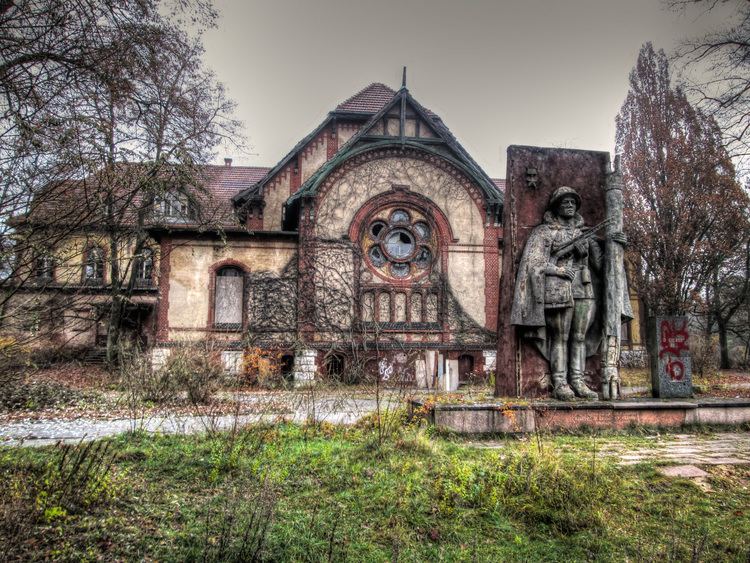Postal codes 14547 Population 11,963 (31 Dec 2008) | Time zone CET/CEST (UTC+1/+2) Dialling codes 033204 Local time Wednesday 8:57 PM | |
 | ||
Weather 2°C, Wind SW at 11 km/h, 98% Humidity Points of interest Beelitz‑Heilstätten, Baum & Zeit, CLIMB UP! ‑ Kletterwal, Tourismusverband Fläming eV, Riebener See | ||
Beelitz is a historic town in Potsdam-Mittelmark district, in Brandenburg, Germany. It is chiefly known for its cultivation of white asparagus (Beelitzer Spargel), which is quite popular within the Berlin-Brandenburg region.
Contents
- Map of 14547 Beelitz Germany
- Geography
- History
- Beelitz Heilsttten
- International relations
- Sons and daughters of the city
- People connected to the city
- References
Map of 14547 Beelitz, Germany
Geography
Beelitz is situated about 18 km (11 mi) south of Potsdam, on the rim of the Zauche glacial sandur plain. The town is surrounded by extended pine woods of the Nuthe-Nieplitz Nature Park.
Located on an old trade route from Berlin to Leipzig, today the Bundesstraße 2, it also has access to the Bundesautobahn 9 at the Beelitz-Heilstätten and Beelitz junctions. Train service to Potsdam and Berlin via the Berlin-Blankenheim railway line is available at two railway stations.
History
A 997 deed by Emperor Otto III mentions a settlement with the Slavic name Belizi, though this denotation may also refer to the nearby town of Belzig.
The Saint Mary and Saint Nicholas parish church was first mentioned in a 1247 report of a Jewish host desecration, and bleeding host miracle, that made Beelitz a medieval pilgrimage site. Since 1370 the host was kept in a small chapel adjacent to the church. The reason for the former name of the Judenberg (renamed Friedensberg after 1945) before the Mühlentor is not confirmed, though tradition indicates it was the site of the burning of Jews.
When in 1731 King Frederick William I of Prussia billeted a hussar regiment, Beelitz became a garrison town and today is home to a Bundeswehr command. The cultivation of asparagus was first documented in 1861.
The village of Kanin, a subdivision of Beelitz since 2001, had been an exclave of the Electorate of Saxony until 1815 and therefore a notorious smuggling area as well as a destination for deserters from the Prussian army. Its fieldstone church was erected about 1138 and today is the oldest preserved one within the Brandenburg state.
In 1928, the Telefunken company erected a radio station in the subdivision of Schönefeld for the wireless communication with North America. Together with the Nauen Transmitter Station, it was incorporated by the Reichspost in 1932. After World War II, the station was used by the Deutsche Post of the GDR until it finally went out of service in 1991.
Beelitz-Heilstätten
Beelitz-Heilstätten (52°15′37″N 12°55′30″E), a district of the town, is home to a large hospital complex of about 60 buildings including a cogeneration plant erected from 1898 on according to plans of architect Heino Schmieden. Originally designed as a sanatorium by the Berlin workers' health insurance corporation, the complex from the beginning of World War I on was a military hospital of the Imperial German Army. During October and November 1916, Adolf Hitler recuperated at Beelitz-Heilstätten after being wounded in the leg at the Battle of the Somme.
In 1945, Beelitz-Heilstätten was occupied by Red Army forces, and the complex remained a Soviet military hospital until 1995, well after the German reunification. In December 1990, Erich Honecker was admitted to Beelitz-Heilstätten after being forced to resign as the head of the East German government.
Following the Soviet withdrawal, attempts were made to privatize the complex, but they were not entirely successful. Some sections of the hospital remain in operation as a neurological rehabilitation center and as a center for research and care for victims of Parkinson's disease. The remainder of the complex, including the surgery, the psychiatric ward, and a rifle range, was abandoned in 1994. As of 2007, none of the abandoned hospital buildings or the surrounding area were secured, giving the area the feel of a ghost town. This has made Beelitz-Heilstätten a destination for curious visitors and a film set for movies like The Pianist in 2002, the Rammstein music video Mein Herz brennt,, Valkyrie in 2008, and A Cure for Wellness in 2016.
International relations
Beelitz is twinned with:
